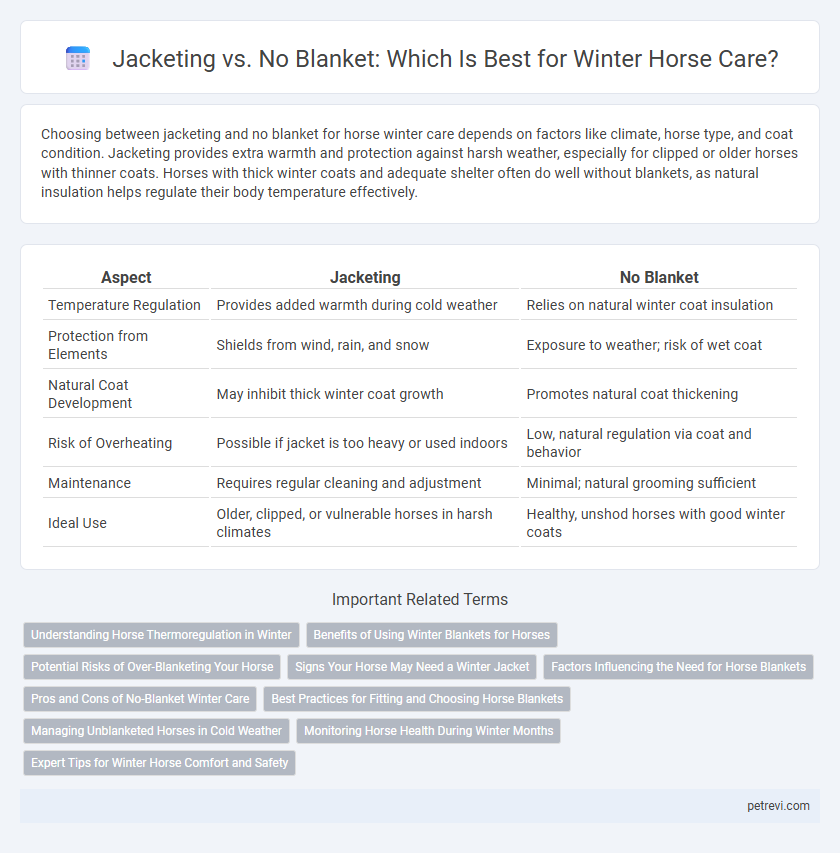Choosing between jacketing and no blanket for horse winter care depends on factors like climate, horse type, and coat condition. Jacketing provides extra warmth and protection against harsh weather, especially for clipped or older horses with thinner coats. Horses with thick winter coats and adequate shelter often do well without blankets, as natural insulation helps regulate their body temperature effectively.
Table of Comparison
| Aspect | Jacketing | No Blanket |
|---|---|---|
| Temperature Regulation | Provides added warmth during cold weather | Relies on natural winter coat insulation |
| Protection from Elements | Shields from wind, rain, and snow | Exposure to weather; risk of wet coat |
| Natural Coat Development | May inhibit thick winter coat growth | Promotes natural coat thickening |
| Risk of Overheating | Possible if jacket is too heavy or used indoors | Low, natural regulation via coat and behavior |
| Maintenance | Requires regular cleaning and adjustment | Minimal; natural grooming sufficient |
| Ideal Use | Older, clipped, or vulnerable horses in harsh climates | Healthy, unshod horses with good winter coats |
Understanding Horse Thermoregulation in Winter
Horse thermoregulation in winter relies on natural mechanisms such as piloerection, which increases insulation by trapping air in the coat. Blanketing, or jacketing, can impede this process by compressing the hair and reducing the horse's natural thermal barrier. Understanding these physiological responses helps determine when a blanket is necessary, typically in cases of clipped horses, older animals, or extreme cold conditions.
Benefits of Using Winter Blankets for Horses
Winter blankets for horses provide essential insulation that helps maintain body temperature during cold months, reducing the risk of hypothermia and other cold-related health issues. These blankets shield horses from wind, rain, and snow, preventing chills and promoting overall comfort, especially for older or thinner-coated horses. Consistent use of winter jackets can also minimize energy expenditure needed for heat production, supporting better weight maintenance and muscle condition throughout winter.
Potential Risks of Over-Blanketing Your Horse
Over-blanketing horses in winter can lead to overheating, causing excessive sweating that may result in skin infections or fungal diseases such as rain rot. Restricting natural thermoregulation with heavy blankets increases the risk of heat stress, especially during exercise or fluctuating temperatures. Inappropriate blanket use can also interfere with the horse's natural coat development, compromising its ability to insulate effectively in cold conditions.
Signs Your Horse May Need a Winter Jacket
Horses showing signs such as shivering, excessive weight loss, a dull coat, or reluctance to move during cold weather may benefit from a winter jacket. Older horses, those with thin coats, or animals recovering from illness often require extra warmth to maintain body heat and prevent hypothermia. Monitoring behavior changes and physical condition helps determine if a blanket is necessary to ensure optimal winter care.
Factors Influencing the Need for Horse Blankets
Factors influencing the need for horse blankets include the horse's coat thickness, age, health condition, and housing environment. Horses with thin coats, older horses, and those with health issues typically require jackets for insulation during cold winter months. Shelter availability and temperature fluctuations also play crucial roles in determining whether blanketing is necessary.
Pros and Cons of No-Blanket Winter Care
No-blanket winter care allows horses to develop natural insulation through their thick winter coat, enhancing their ability to regulate body temperature effectively. This approach reduces the risk of sweat accumulation that can cause chills and skin conditions, promoting better respiratory health. However, horses without blankets require adequate shelter and consistent access to high-quality forage to maintain energy levels necessary for natural warmth during cold and wet weather.
Best Practices for Fitting and Choosing Horse Blankets
Proper fitting of horse blankets requires measuring the horse's length from withers to tail and ensuring the blanket covers fully without restricting movement or causing rubbing. Selecting the right blanket material, such as waterproof and breathable fabrics, enhances protection during harsh winter conditions while preventing overheating. Regularly checking and adjusting straps helps maintain comfort and effectiveness, preventing pressure sores and ensuring the horse stays warm without unnecessary bulk.
Managing Unblanketed Horses in Cold Weather
Managing unblanketed horses in cold weather requires ensuring they have access to shelter that protects from wind and moisture, as wet or icy conditions can lead to hypothermia. Adequate nutrition is crucial to support increased metabolic heat production, with high-quality forage like hay providing necessary energy. Regular health checks and grooming help maintain a healthy coat and detect early signs of cold stress or illness.
Monitoring Horse Health During Winter Months
Monitoring horse health during winter requires careful observation of body condition and behavior to determine if jacketing is necessary. Horses without blankets may conserve natural warmth but need increased feed and shelter access to maintain energy and prevent weight loss. Regular checks for signs of cold stress or illness ensure optimal winter care regardless of jacketing choices.
Expert Tips for Winter Horse Comfort and Safety
Experts recommend assessing a horse's individual coat thickness and living conditions before deciding on blanketing, as thick-coated horses often maintain warmth without a jacket. Properly fitted jackets prevent overheating and chafing while enhancing insulation during severe winter weather. Regular monitoring of a horse's weight, hydration, and behavior ensures optimal comfort and safety throughout the cold season.
Jacketing vs No Blanket for Horse Winter Care Infographic

 petrevi.com
petrevi.com